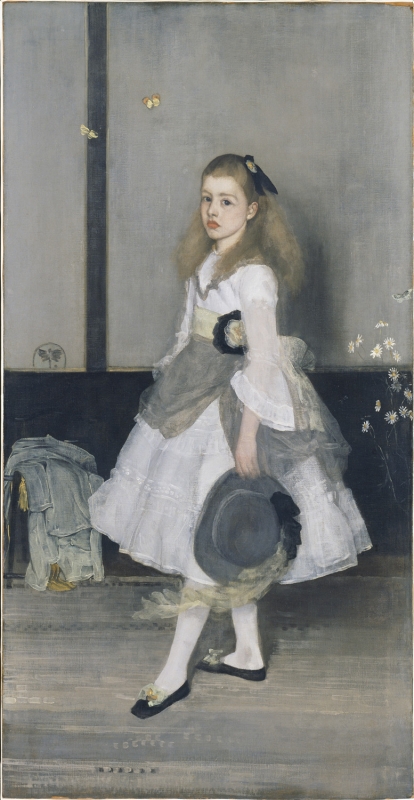Harmony in Grey and Green: Miss Cicely Alexander dates mainly from 1872 but was probably completed in the following year. 1
According to William Cleverly Alexander (1840-1916), he commissioned Whistler to paint his daughters in 1872 because he liked Arrangement in Grey and Black: Portrait of the Painter's Mother [YMSM 101]; he also said that Harmony in Grey and Green: Miss Cicely Alexander was started just before Arrangement in Grey and Black, No. 2: Portrait of Thomas Carlyle [YMSM 137]. 2
Whistler's biographers, the Pennells, also wrote that Harmony in Grey and Green: Miss Cicely Alexander was begun before Arrangement in Grey and Black, No. 2: Portrait of Thomas Carlyle was finished. 3
Although Whistler had planned to start with a portrait of another of W. C. Alexander's daughters, Agnes Mary ('May') Alexander (1862-1950) (presumably the portrait now known as Miss May Alexander [YMSM 127]), he changed his mind and wrote to ask her mother, Rachel Agnes Lucas (Mrs W. C. Alexander) (1837-1900), if he could paint the younger sister, Cicely Henrietta, instead: 'I should work at the present moment, with more freshness at this very "fair arrangement" I propose to myself, than at any other.' 4
Cicely was certainly posing in August 1872, and on 26 August Whistler asked, using his mother as amanuensis, if a new dress could be made, before the next sitting on the following Friday. 5 In November 1872 Whistler's mother Anna Matilda Whistler (1804-1881) said that Cicely was posing twice a week: 'Jemie is painting a life size Portrait of his 2nd little daughter, nearly finished now, Mrs A[lexander] has been bringing Cecily twice a week to stand in the Studio.' 6 Alexander sent Whistler £50, and thought, from his daughter's account, that the picture needed only a few more sittings:
'I enclose notes for £50 - in £5 - nos - 56437-46 16th Octr 72 ammunition which will keep your enemies off. Cissy gives her opinion of the portrait in very flattering terms - From the place where she stands it looks a daub but when she stands opposite to it[,] it is very pretty and I shall soon have two Cissys - A very few more sittings will I suppose bring completion to what will I am sure be a most charming work - and one which must add to your fame.' 7
In the end, the portrait, Harmony in Grey and Green: Miss Cicely Alexander, required over 70 sittings before it was completed. 8
It was first exhibited at Mr Whistler's Exhibition, Flemish Gallery, 48 Pall Mall, London, 1874 (cat. no. 5) as 'Portrait, "Harmony in Grey and Green" '. Yet even after that, when he was about to start on the portrait of Cicely's sister at Aubrey House, Whistler asked the sitter's mother,
'I think I may promise to make very little "mess" and to give not so much trouble to my new sitter as I did to poor Cissie! How is Cissie and am I forgiven yet? - How does her picture look? and have you any secret wish that I should do anything to it? for may be a touch might easily be given to it while there.' 9
Notes:
1: YMSM 1980 [more] (cat. no. 129).
2: Cary 1907[more] , pp. 187-88.
3: Pennell 1908 [more] , vol. 1, pp. 171-75.
5: A. M. and J. Whistler to R. A. Alexander, 26 August [1872], GUW #07571.
6: A. M. Whistler to J. H. Gamble, 5 and 22 November 1872, GUW #06553.
7: Alexander to Whistler, 21 December 1872, GUW #00138.
Last updated: 5th June 2021 by Margaret






